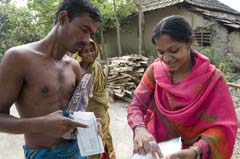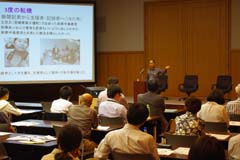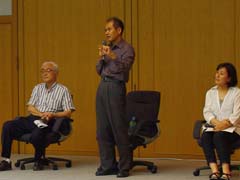The water of life to Bangladesh: Seminar held on the Arsenic Mitigation Project
2015.07.27
For many years, JICA and the Japanese NGO the Asia Arsenic Network have jointly implemented an arsenic contamination mitigation project in Bangladesh. On July 15, 2015, the JICA Research Institute held a seminar in Tokyo to commemorate the Institute's recent publication in Japan of a book on the arsenic mitigation project in Bangladesh.

Survey is done on the occurrence of arsenic
poisoning(Photo: Mika Tanimoto/JICA)
Bangladesh has been experiencing groundwater contamination by arsenic for decades. Some 30 million people are said to be suffering from the contamination. The book was written by Mr. Kazuyuki Kawahara, a founding member of the Asia Arsenic Network, who has tackled the problem in Bangladesh since 2000 as JICA's advisor on arsenic mitigation.
In his opening remarks, JICA-RI Director Ichiro Tambo said that this book is a record of a "frontier" collaboration project between Japanese ODA and NGOs. He also noted that the book is outstanding in showing a good example of applying the expertise obtained from Japan's experience in overcoming environmental pollution problems to similar problems in developing countries. The book represents 20 years of history of challenging the arsenic problems by Mr. Kawahara, the author of the book. Mr. Tambo said, "This is a good occasion to listen to Mr. Kawahara's life history, his struggle in Bangladesh, and the efforts made by all the parties involved. I am interested in what powered his drive."
Mr. Kawahara first encountered the arsenic problem in the Toroku Mine in Miyazaki Prefecture, in southern Japan in 1971. At the time, he was a reporter for the Asahi Shimbun, one of Japan's most representative newspapers. After he left the newspaper, he began recording the history of Toroku and devoted great effort to the pursuit of the Mine's responsibility and support for the victims. After the amicable settlement in the Supreme Court, he established the Asia Arsenic Network in 1994 and embarked on the investigation of arsenic-contamination in Asia. The words of the Toroku victims, "Go help other people who are similarly suffering from arsenic," motivated Kawahara.

Kazuyuki Kawahara delivers his speech
In his speech, Mr. Kawahara introduced the construction of the Arsenic Iron Removal Plant (AIRP). The plant uses a gravel and sand filter to remove arsenic and iron from well water, thereby providing safe water in areas where alternative water sources are not available. The local government hired water inspectors for operation and management of the plant, and the residents paid a service fee of 10 taka. This system was often criticized for being "extremely labor-intensive" but "having no exit strategy," Mr. Kawahara said. "Things won't change without work being done. It is important to develop young people and pass on what we have achieved."

Speakers answer questions from the floor
Next, Mr. Kunio Takahashi, a member of the Steering Committee of the Japan Association of Drainage and Environment (JADE), made a comment. He is engaged in promoting "EcoSan toilets" (ecological sanitation toilets) which separate human excreta (i.e., urine and feces) and process them into fertilizer in rural areas in Bangladesh. He points out that people are willing to pay for the service once they understand its benefits. Therefore, convincing the residents of the benefits is a key to success, a common challenge to both his and Kawahara's activities in Bangladesh.
Ms. Michiru Sasagawa, the Chairman of People for Rainwater, is engaged in the Rainwater Tank Social Business Project to promote safe water in Bangladesh. She stated, "Rainwater is one effective means to safe water" in Bangladesh where arsenic and salt contamination are serious issues.
In the question and answer session, participants made comments or asked questions such as "It is difficult to educate people about the danger of arsenic because it is not an immediate threat to life," and "How can we maintain the technology and expertise after termination of the project?"

事業事前評価表(地球規模課題対応国際科学技術協力(SATREPS)).国際協力機構 地球環境部 . 防災第一チーム. 1.案件名.国 名: フィリピン共和国.

事業事前評価表(地球規模課題対応国際科学技術協力(SATREPS)).国際協力機構 地球環境部 . 防災第一チーム. 1.案件名.国 名: フィリピン共和国.

事業事前評価表(地球規模課題対応国際科学技術協力(SATREPS)).国際協力機構 地球環境部 . 防災第一チーム. 1.案件名.国 名: フィリピン共和国.

事業事前評価表(地球規模課題対応国際科学技術協力(SATREPS)).国際協力機構 地球環境部 . 防災第一チーム. 1.案件名.国 名: フィリピン共和国.

事業事前評価表(地球規模課題対応国際科学技術協力(SATREPS)).国際協力機構 地球環境部 . 防災第一チーム. 1.案件名.国 名: フィリピン共和国.
scroll